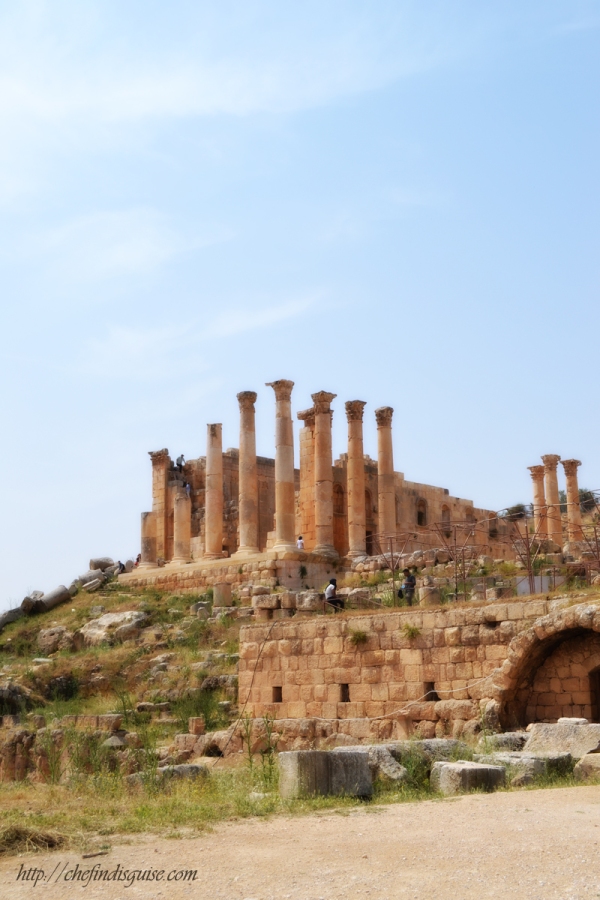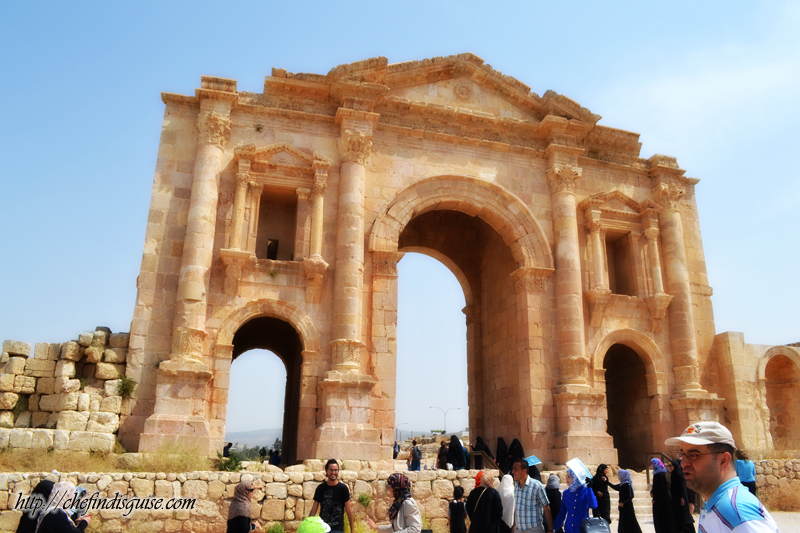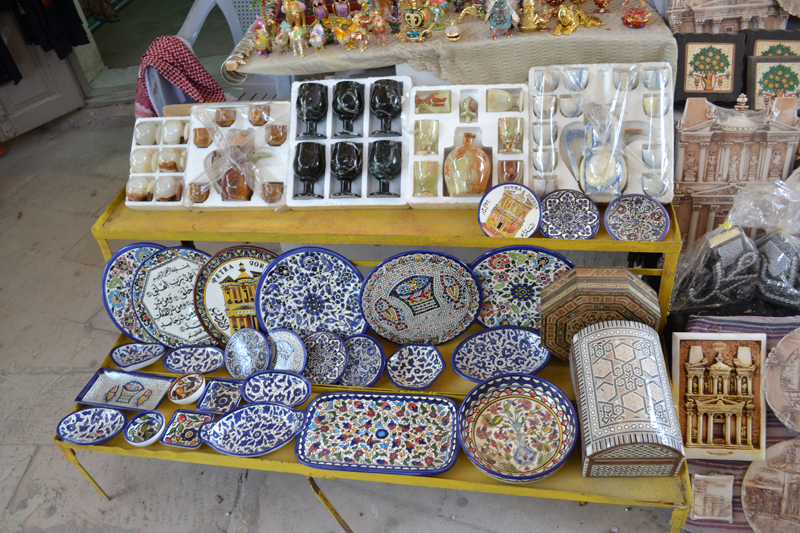Today we step away from our regular food related posts. With the kids off from school and the current political atmosphere surrounding Jordan we decided to stay here this summer and use the vacation to take the kids in a tour in Jordan. A couple of weeks ago we went to Jerash. A city located north of the Jordanian capital Amman.Although Petra is Jordan’s most famous landmark, Jerash is definitely a close second in importance but it is sadly a city that few tourists get to visit or see.
What makes Jerash special is the fact that it is considered one of the most important and best preserved Roman cities in the Near East.Often called the Rome away from Rome, Jerash is the site of the ruins of the Greco-Roman city of Gerasa, also. It is sometimes misleadingly referred to as the “Pompeii of the Middle East or Asia”, referring to its size, extent of excavation and level of preservation (though Jerash was never buried by a volcano). Jerash was a city of the Decapolis (a group of ten cities on the eastern frontier of the Roman Empire. The ten cities were not an official league or political unit, but they were grouped together because of their language, culture, location, and political status, with each possessing a certain degree of autonomy and self-rule)
The drive takes 40 minutes from Amman. As one approaches, you are suddenly faced with a wonderful view. On your right the ruins of the city with the Triumphal Arch(the one you see in the top picture) in the foreground standing tall and proud. On the other side of the highway lies the modern town of Jerash.
You start your visit to Jerash with the crafts market at the gate, local craftsmen sell souvenirs ranging from bottles filled with sand paintings to handmade pottery plates.
I would advise you to postpone buying souvenirs because you will be coming out the same way and the long walk ahead will be much easier without the extra luggage.
Make sure you have comfortable shoes, lots for water and a hat to protect you from the sun, this is going to be a long yet very enjoyable walk.

The first monument that meets you when you go into the ruins is the Arch of Hadrian (The one you see in the top picture). This was not the original gate of the city, it was actually built to honor the visit of the Roman emperor Hadrian to Jerash in 129/130 AD. It consists of a large central arch, topped by a pediment, and flanked by two smaller arches with “Syrian niches” above them; all three arches originally supported wooden doors

Next on your right is the hippodrome ( a stadium for horse racing and chariot racing). The Hippodrome in Jerash has ten starting gates The seating area was 4m deep with sixteen rows of seats. The seats accommodated 15,000 spectators! (you can tell how popular chariot racing must have been!) Twice a day, there is a show were you have a chance to see the hippodrome come back to life.


The Jerash Heritage Company has daily ticketed performances of the Roman Army and Chariot race. It features 45 legionaries in full armour in a display of Roman Army drill and battle tactics, ten gladiators fighting “to the death,” and several Roman chariots competing in a classical seven lap race around the ancient hippodrome. You can get a glimpse of that chariot race in this video
As you leave the hippodrome behind you finally come to the Southern gate of the city and wall of the city.(You can see the ruminants of the wall to the left of the gate).
Built in 13 AD, the South Gate was one of five gates into the city of Gerasa. Upon construction, it was just a symbolic entrance into the city, but when the fortified walls encircling Gerasa were built by Emperor Theodosius I in the 4th century AD, the arch became a proper gateway. The acanthus leaves decorating the base of the pillars on its façade – a feature unique to Jerash – are said to have inspired the Arch of Hadrian, which was built in the following century.The present walls are Byzantine and had a total length of 3456 m. The South Gate through which you enter Jerash, dates from 130 AD


Once you cross the gate the real trip back in time starts. First comes the oval plaza . The plaza is surrounded by a broad sidewalk and a colonnade of 1st century Ionic columns. There are 2 altars in the middle, and a fountain was added in the 7th century AD. The oval plaza measures 90 metres in length and 80 metres in width and is surrounded by a colonnade of 56 Ionic columns. The ground is paved with limestone in a pattern that traces the oval shape of the Plaza.

The function of the oval plaza has been debated. Initially, it was believed to be the city’s marketplace, but some historians believe that the Oval Plaza was an extension of the Temple of Zeus, where religious processions would have arrived after traversing the length of the Cardo Maximus and before entering the enclosure of the Temple.

To your left on a hill overlooking the plaza is one of two great temples in Jerash, the Temple of Zeus. It is dedicated to the Hellenistic god Zeus, one of the two patron gods of the city. The structure that has survived to this day, albeit in ruins, was completed in 162 AD as a replacement to a first century AD Roman temple, which in turn had been built on the site of an older Hellenistic temple. Prior to the arrival of the Romans, the Hellenistic temple had served as the Acropolis of Gerasa. Some of the stones used in the construction of the Roman temple are thought to have belonged to these predecessors. In the last Roman construction, a staircase provided access from the Oval Plaza to the Temple, which consisted of a Temenos (sacred enclosure), built over a raised platform, and a Cella (inner sanctuary, or the temple itself) on the highest level of the Temple. The temenos was supported below by dark vaulted corridors, which nowadays host a small exhibition dedicated to the Temple of Zeus and other monuments in Jerash. In the following picture you can see a model of the Temple of Zeus in its heyday on display at this exhibition. (Picture source)


Stretching north from the Oval Plaza is the Cardo Maximus, the main Roman road in Jerash. It is still paved with its original stones and bears the ruts of chariot wheels.
As part of a remodeling of the street around 170 AD, the original Ionic columns were replaced with a more decorative Corinthian colonnade. The Cardo was lined with a broad sidewalk and shops and an underground sewage system ran the full length of the street, into which rainwater was channeled through holes on the sides of the street! What I found fascinating about the paving stones is that they ran diagonally from side to side but every 50 meters or so the pattern is interrupted with a horizontal row . I have yet to find the explanation for this.
At the height of Jerash’s power, there were 500 columns lining it, all of different heights to match the buildings that stood behind them. The general rule seemed to be ‘the taller the column, the more important the building’

Completed in 96 AD under Emperor Domitian, the South theater is one of two in Jerash. In its original form it had the capacity for 5000 spectators, but the reconstruction effort of recent decades restored its capacity only up to 3000. The South Theatre is located immediately behind the Temple of Zeus and it continues to hold events, particularly during the Jerash Festival. During our visit there was a bagpipe performance there.
It is amazing how a little music and a smile can melt cultural and language boundaries. People in the theater, tourists and locals, old and young simply clasped hands and started going around doing dabkeh (a traditional form of dancing here)
In the grooves in the stairs leading up to the seating area in the theater, these flowers reminded me of my rose that grew from the concrete
To prevent this post from becoming too long, we will continue our trip in Jerash next week. There is still many fascinating landmarks to see, so do come back to enjoy the rest of this journey with me
































